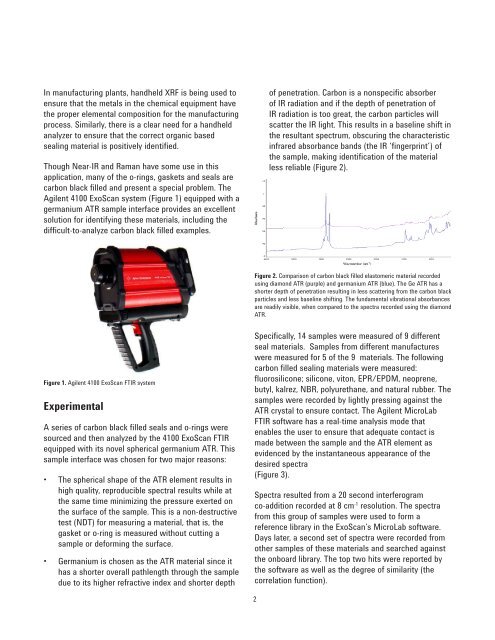Application Compendium - Agilent Technologies
Application Compendium - Agilent Technologies
Application Compendium - Agilent Technologies
Create successful ePaper yourself
Turn your PDF publications into a flip-book with our unique Google optimized e-Paper software.
In manufacturing plants, handheld XRF is being used to<br />
ensure that the metals in the chemical equipment have<br />
the proper elemental composition for the manufacturing<br />
process. Similarly, there is a clear need for a handheld<br />
analyzer to ensure that the correct organic based<br />
sealing material is positively identified.<br />
Though Near-IR and Raman have some use in this<br />
application, many of the o-rings, gaskets and seals are<br />
carbon black filled and present a special problem. The<br />
<strong>Agilent</strong> 4100 ExoScan system (Figure 1) equipped with a<br />
germanium ATR sample interface provides an excellent<br />
solution for identifying these materials, including the<br />
difficult-to-analyze carbon black filled examples.<br />
Figure 1. <strong>Agilent</strong> 4100 ExoScan FTIR system<br />
Experimental<br />
A series of carbon black filled seals and o-rings were<br />
sourced and then analyzed by the 4100 ExoScan FTIR<br />
equipped with its novel spherical germanium ATR. This<br />
sample interface was chosen for two major reasons:<br />
• The spherical shape of the ATR element results in<br />
high quality, reproducible spectral results while at<br />
the same time minimizing the pressure exerted on<br />
the surface of the sample. This is a non-destructive<br />
test (NDT) for measuring a material, that is, the<br />
gasket or o-ring is measured without cutting a<br />
sample or deforming the surface.<br />
• Germanium is chosen as the ATR material since it<br />
has a shorter overall pathlength through the sample<br />
due to its higher refractive index and shorter depth<br />
2<br />
of penetration. Carbon is a nonspecific absorber<br />
of IR radiation and if the depth of penetration of<br />
IR radiation is too great, the carbon particles will<br />
scatter the IR light. This results in a baseline shift in<br />
the resultant spectrum, obscuring the characteristic<br />
infrared absorbance bands (the IR ‘fingerprint’) of<br />
the sample, making identification of the material<br />
less reliable (Figure 2).<br />
Figure 2. Comparison of carbon black filled elastomeric material recorded<br />
using diamond ATR (purple) and germanium ATR (blue). The Ge ATR has a<br />
shorter depth of penetration resulting in less scattering from the carbon black<br />
particles and less baseline shifting. The fundamental vibrational absorbances<br />
are readily visible, when compared to the spectra recorded using the diamond<br />
ATR.<br />
Specifically, 14 samples were measured of 9 different<br />
seal materials. Samples from different manufactures<br />
were measured for 5 of the 9 materials. The following<br />
carbon filled sealing materials were measured:<br />
fluorosilicone; silicone, viton, EPR/EPDM, neoprene,<br />
butyl, kalrez, NBR, polyurethane, and natural rubber. The<br />
samples were recorded by lightly pressing against the<br />
ATR crystal to ensure contact. The <strong>Agilent</strong> MicroLab<br />
FTIR software has a real-time analysis mode that<br />
enables the user to ensure that adequate contact is<br />
made between the sample and the ATR element as<br />
evidenced by the instantaneous appearance of the<br />
desired spectra<br />
(Figure 3).<br />
Spectra resulted from a 20 second interferogram<br />
co-addition recorded at 8 cm -1 resolution. The spectra<br />
from this group of samples were used to form a<br />
reference library in the ExoScan’s MicroLab software.<br />
Days later, a second set of spectra were recorded from<br />
other samples of these materials and searched against<br />
the onboard library. The top two hits were reported by<br />
the software as well as the degree of similarity (the<br />
correlation function).

















